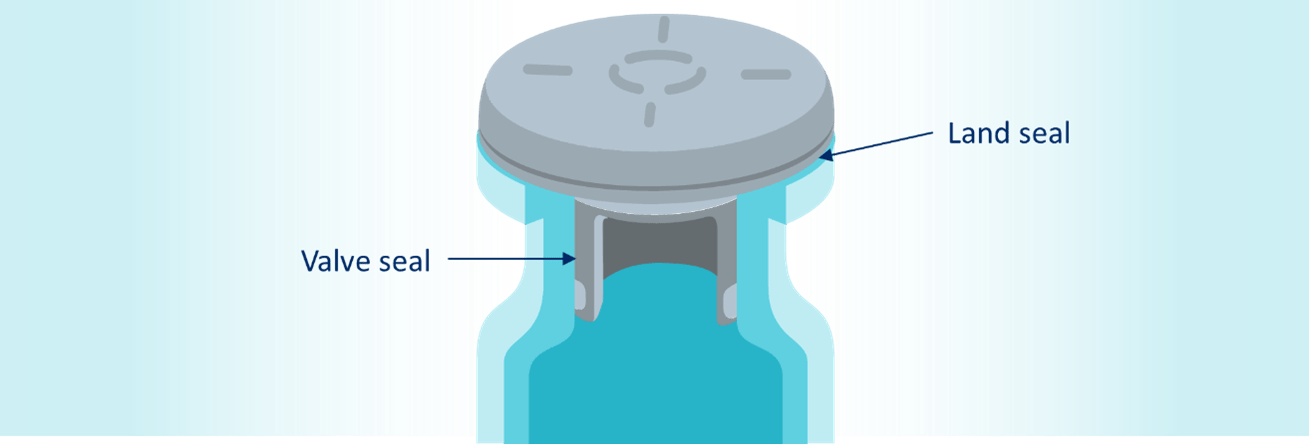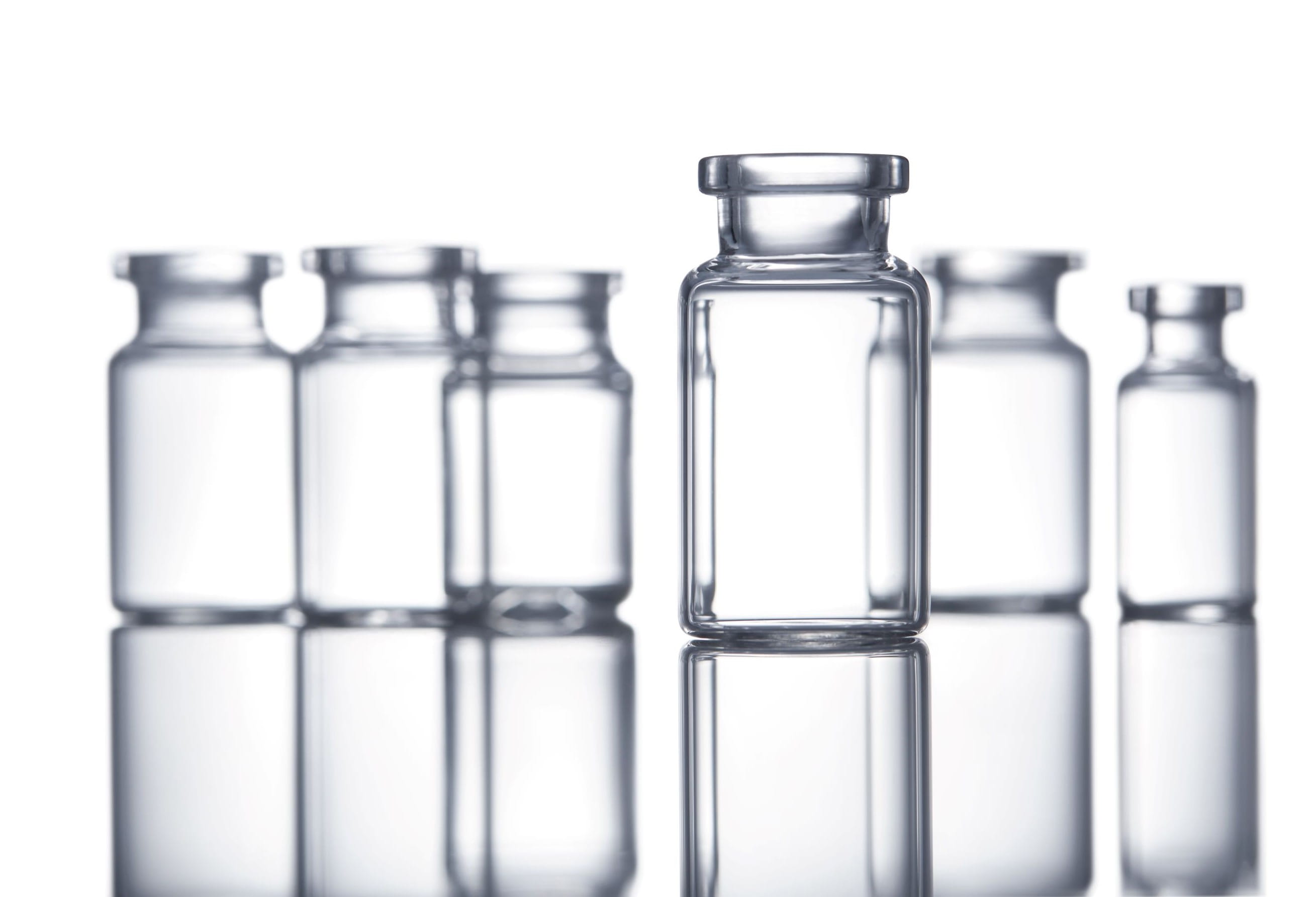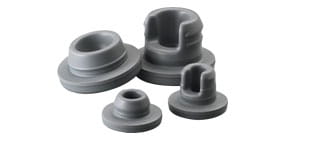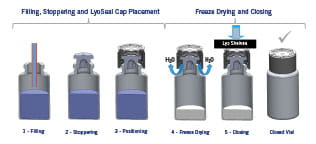Stopper Pop Up During Fill Finish Operations
Liquid injectable drugs can be contained in a pre-filled syringe system, a cartridge-based system, or a vial-based system (with a rubber stopper and seal). For a vial-based system, the drugs first are aseptically filled into glass or polymer vials. During the subsequent Fill & Finish operations, the vials are closed temporarily by inserting a rubber stopper into the vial orifice. This is prior to crimping with an aluminum seal, which results in the final integral vial-based container closure system.
![]()

The Fill & Finish operations in an aseptic cleanroom environment require dedicated process steps to keep the inserted stopper in place until the seal has been placed and crimped over the stopper and vial flanges. Here the compression of the rubber stopper flange is essential to help achieve the permanent land seal between the stopper and vial flange.
After filling the liquid drug into the vial and prior to the final crimping procedure, the stopper insertion step requires a well-placed and fully-inserted stopper to maintain temporary vial integrity and drug safety. However, vials with inserted stoppers are moved on the tracks of the Fill & Finish line and there may be occurrences of stopper pop up. The extent of these raised stoppers may be described as ranging from partially-lifted stopper flanges, to stoppers being lifted from vials, to the worst-case scenario of stoppers removed from vials completely.
Selected potential aspects that can result in this issue of pop up are listed below. This list is not exhaustive and can be extended depending on the specific situation. Contributing factors are grouped based upon material attributes, design and dimensional fit, filling equipment operation/environment, and human factors:
- Material attributes and contact surfaces between rubber stoppers and vials
- Design fit of stoppers to vials
- Dimensional fit of stoppers with the inner vial neck walls
- Temperature and head space volume in vial
- Fill & Finish line set up and filling process
Each factor is described in some detail below.
Material Attributes and Contact Surfaces between Rubber Stoppers and Vials
The stopper may be composed of pharmaceutical rubber only. However, for demanding drug products, a stopper design may be selected which includes a fluorpolymer film laminated to the plug part on the drug contact side, e.g., FluroTec® barrier film which is available from West. Such a laminated film would act as a barrier between the drug and the rubber material. The stopper and vial interfaces may vary in roughness depending on the rubber manufacturing process or the presence of a fluorpolymer film. In addition, the coating of a stopper by liquid silicone oil, or even a spray cross-linked coating like B2-coating technology, will add lubricity and hence would impact the friction between the stopper and vial interfaces. In some cases, vials themselves may have received a siliconization treatment as well. The extent of lubricity from all these treatments would influence the optimized forces required for stopper insertion. Another factor is that the sterilization method can potentially influence the physical properties of rubber stoppers. Differences may be due to sterilization by gamma irradiation at high doses versus sterilization by steam (see West Technical Report TR 2011140 Impact of Steam and Gamma Processing on Elastomers). Even parameters like the drying time and exposure time at high temperatures can influence the material properties of the rubber stoppers and hence insertion.
Design Fit of Stoppers to Vials
ISO standards describe the vial neck finish of tubular glass vials and mention three styles: American blowback, European blowback, and non-blowback. They describe a presence and shape of a horizontal groove inside the inner vial orifice in the case of the American blowback style, while the European blowback style simply has an undercut feature inside the top inner glass vial. A non-blowback glass vial has a smooth inner neck wall that neither has a groove nor an undercut feature. These different types of vial neck finish styles are intended to be combined with the appropriate stopper plug part shape, which would show an additional horizontal rubber ring underneath the stopper flange to be fitted into groove or undercut of the vial. In an ideal set up, the recommendation is to use the combination of the well-fitting design styles of a vial and stopper type.
Dimensional Fit of Stoppers with the Inner Vial Neck Wall
Interference fit between the stopper plug part diameter and the inner vial neck diameter is critical to ensure an appropriate container closure system. It is key to consider the component tolerance ranges to ensure the press fit between the inserted stopper and the vial orifice is sufficient to hold the stopper in place and assure for a temporarily safely stoppered vial, until the cap is finally crimped around the stopper and vial flanges to form the integral container closure system.
Temperature and Head Space Volume in Vial
High levels of filled liquid drug inside a vial leave less available gas headspace. If a cold liquid drug would warm quickly, the gas phase is expected to expand, which may increase the vial system interior pressure. In situations of a small headspace this could lead to the stopper being lifted from its position.
Fill & Finish Line Set Up and Filling Process
The Fill & Finish line operation is based on optimized equipment and detailed validation procedures. Vibrations of the stations and tested operations of the process steps will ensure, with properly adjusted parameters, a smooth run for the filling, stoppering, and crimping operations. The liquid dispensing unit should avoid drug formulation splashes, in order not to have droplets near the vial orifice. The stopper insertion process needs to mitigate the risk of misplacement to enable a smooth and full stopper insertion with appropriate insertion force and holding time. Finally, an in-process camera inspection will detect raised stoppers prior to those units being transported to the crimping station.
Control of these aspects, among others, will help to ensure the assembly of an integral container closure system to provide for a sterile product package ensuring the safety of patients. For stopper, vial, and process recommendations, please contact the West Technical Customer Support Team or visit the West Knowledge Center.
FluroTec is a registered trademark of West Pharmaceutical Services, Inc., in the United States and other jurisdictions.
FluroTec and B2-coating technologies are licensed from Daikyo Seiko, Ltd.












